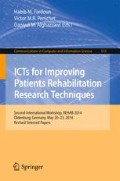Abstract
This chapter presents an intuitive user interface based on a self-adaptive architecture. It uses a consumer-range 3D hand capture device that allows its users to interactively edit objects in 3D space. While running, the system monitors the user’s behaviors and performance in order to maintain an up-to-date user model. This model then drives the re-arrangement and reparameterization of a rule-based system that controls the interaction. A user study let us define the initial parameters of this self-adaptive system. This preliminary study was conducted in a 3D infographics and animation school on 15 students. The study was both qualitative and quantitative: the qualitative evaluation consisted of a SUMI evaluation questionnaire while the quantitative evaluation consisted of analysing manually annotated recordings of the subjects together with a fine-grained log of the interaction mechanics. We believe that the self-adaptive aspects of the system is well suited to the problematics of rehabilitation. This system could, from the beginning, adapt to both the user’s impairments and needs, then follow and adapt its interaction logic according to the user’s progress. Such a system would, for instance, enable a clinician or a therapist to design tailored rehabilitation activities accounting for the patient’s exact physical and physiological condition.
Access this chapter
Tax calculation will be finalised at checkout
Purchases are for personal use only
Notes
- 1.
http://www.xbox.com/kinect (10 September 2014).
- 2.
http://www.leapmotion.com (10 September 2014).
- 3.
http://supinfocom.rubika-edu.com/ (10 September 2014).
- 4.
http://www.autodesk.fr/products/3ds-max/overview (10 September 2014).
- 5.
http://www.autodesk.fr/products/maya/overview (10 September 2014).
- 6.
http://www.blender.org/ (10 September 2014).
- 7.
http://slsi.dfki.de/software-and-resources/ (10 September 2014).
- 8.
http://sumi.ucc.ie/ (10 September 2014).
- 9.
“windows, icons, menus, pointer”.
References
Alpaydin, E.: Introduction to Machine Learning, 2nd edn. The MIT Press, Cambridge (2010)
Bhuiyan, M., Picking, R.: Gesture-controlled user interfaces, what have we done and whats next. In: Proceedings of the Fifth Collaborative Research Symposium on Security, E-Learning, Internet and Networking (SEIN 2009), pp. 25–29. Darmstadt, Germany (2009)
Chai, J., Hodgins, J.K.: Performance animation from low-dimensional control signals. In: Proceedings of ACM Transactions on Graphics (2005)
Hale, K.S., Stanney, K.M.: Handbook of Virtual Environments: Design, Implementation, and Applications. CRC Press, New York (2014)
Heloir, A., Haudegond, S., Lebrun, Y., Nunnari, F., Kolski, C.: Description of a self-adaptive architecture for upper-limb rehabilitation. In: 2nd ICTs for improving Patient Rehabilitation Research Techniques Workshop REHAB 2014, in conjunction with PervasiveHealth 2014. Oldenbourg, Germany (2014)
Jacko, J.A.: Human-Computer Interaction Handbook: Fundamentals, Evolving Technologies, and Emerging Applications. CRC Press Inc, Boca Raton (2012)
Kim, D., Kim, D.: An intelligent smart home control using body gestures. In: International Conference on Hybrid Information Technology 2006, ICHIT 2006, vol. 2, pp. 439–446 Nov 2006
Kin, K., Agrawala, M., DeRose, T.: Determining the benefits of direct-touch, bimanual, and multifinger input on a multitouch workstation. In: Graphics Interface 2009, GI 2009, pp. 119–124 (2009)
Kipp, M.: Anvil - a generic annotation tool for multimodal dialogue. In: Dalsgaard, P., Lindberg, B., Benner, H., Tan, Z.-H. (eds.) INTERSPEECH, pp. 1367–1370. ISCA (2001)
Kipp, M., Nguyen, Q.: Multitouch puppetry: Creating coordinated 3d motion for an articulated arm. In: ACM International Conference on Interactive Tabletops and Surfaces, ITS 2010, pp. 147–156. ACM, New York (2010)
Kirakowski, J., Corbett, M.: SUMI: the software usability measurement inventory. Br. J. Educ. Technol. 24(3), 210–212 (1993)
Kolski, C.: Human-computer Interactions in Transport. John Wiley & Sons, Hoboken (2011)
L’Abate, L., Kaiser, D.A.: Handbook of Technology in Psychology, Psychiatry and Neurology: Theory, Research, and Practice. Nova Science Publishers, New York (2012)
Lin, J., Igarashi, T., Mitani, J., Liao, M., He, Y.: A sketching interface for sitting pose design in the virtual environment. IEEE Trans. Vis. Comput. Graph. 18(11), 1979–1991 (2012)
Mitra, S., Acharya, T.: Gesture recognition: a survey. IEEE Trans. Syst. Man Cybern. Part C Appl. Rev. 37(3), 311–324 (2007)
Sears, A., Shneiderman, B.: High precision touchscreens: design strategies and comparisons with a mouse. Int. J. Man-Mach. Stud. 34(4), 593–613 (1991)
Stephanidis, C.: The Universal Access Handbook. CRC Press, Boca Raton (2009)
Tzovaras, D.: Multimodal User Interfaces: From Signals to Interaction. Signals and Communication Technology, 1st edn. Springer, Heidelberg (2008). doi:10.1007/978-3-540-78345-9
Wigdor, D.: Brave NUI World: Designing Natural User Interfaces for Touch and Gesture. Morgan Kaufmann, Burlington (2011)
Acknowledgment
Authors would especially like to thank the students who participated to the study as well as Azad Lusbaronian, head of studies at Supinfocom / Rubika SAS for his involvement and the essential help he provided.
Author information
Authors and Affiliations
Corresponding author
Editor information
Editors and Affiliations
Rights and permissions
Copyright information
© 2015 Springer-Verlag Berlin Heidelberg
About this paper
Cite this paper
Heloir, A., Nunnari, F., Haudegond, S., Havrez, C., Lebrun, Y., Kolski, C. (2015). Design and Evaluation of a Self Adaptive Architecture for Upper-Limb Rehabilitation. In: Fardoun, H., R. Penichet, V., Alghazzawi, D. (eds) ICTs for Improving Patients Rehabilitation Research Techniques. REHAB 2014. Communications in Computer and Information Science, vol 515. Springer, Berlin, Heidelberg. https://doi.org/10.1007/978-3-662-48645-0_17
Download citation
DOI: https://doi.org/10.1007/978-3-662-48645-0_17
Published:
Publisher Name: Springer, Berlin, Heidelberg
Print ISBN: 978-3-662-48644-3
Online ISBN: 978-3-662-48645-0
eBook Packages: Computer ScienceComputer Science (R0)

